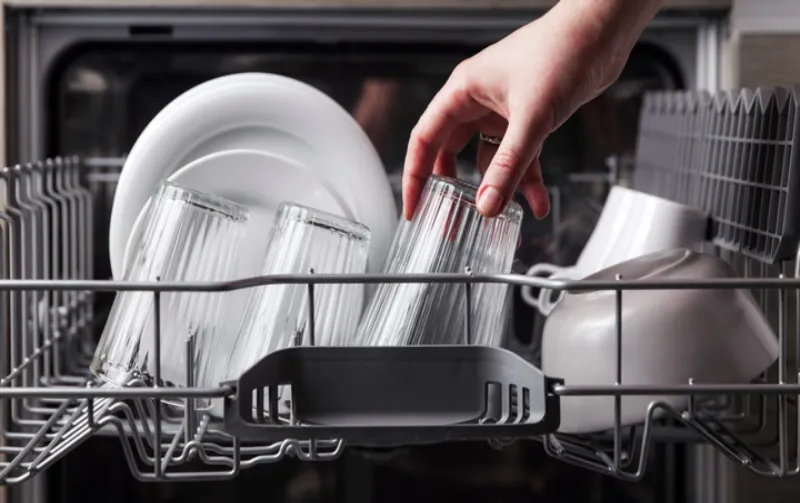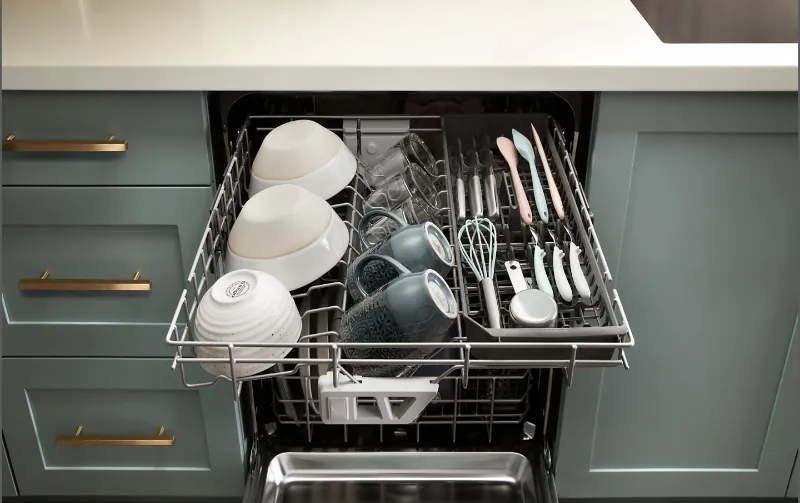Dishwashers can kill bacteria using hot water and detergents. The high temperature during the wash cycle helps eliminate germs.
A dishwasher is an essential home appliance that not only cleans dishes but also ensures they are hygienically safe to use.
By reaching temperatures of around 145°F-155°F in its hot water cycle, it effectively sanitizes plates, cutlery, and cooking utensils.
This makes the dishwasher an ally in maintaining a healthy kitchen environment.
Many modern dishwashers come with a specific sanitization cycle, further bolstering their bacteria-killing capabilities.
This cycle is designed to meet certain standards set by health authorities to ensure a significant reduction of harmful microorganisms.
Regular dishwashers are equipped to handle everyday bacteria, but during flu season or in households with immune-compromised individuals, the extra sanitization feature becomes particularly beneficial.
Embracing the efficiency of dishwashers not only saves time but also supports a germ-free kitchen space.

Understanding The Role Of Heat And Water
An efficient dishwasher does more than just clean; it also serves as a formidable opponent against kitchen bacteria.
Understanding the role of heat and water is pivotal in grasping how dishwashers manage to sanitize and purify your dishes.
Let’s dive into the mechanisms that empower a dishwasher to fight off pathogens effectively.
Hot Water Vs. Bacteria
Temperature plays a crucial role in ensuring the disinfection prowess of your dishwasher.
The heat is essential in the battle against germs and bacteria:
- High temperatures during the washing cycle are critical for the elimination of bacteria.
- Most dishwashers reach water temperatures up to 140-145 degrees Fahrenheit, with some models offering “sanitize” settings that go even higher.
This hot water environment is inhospitable for many microorganisms, as they cannot survive prolonged exposure to such heat.
In effect, the scalding water destroys bacteria, ensuring that your dishes come out not only clean but also hygienically safe.
The Function Of Detergents
While heat is a crucial factor, it works hand in hand with detergents to achieve the desired level of cleanliness. Here’s how:
| Detergent’s Role | Benefit |
|---|---|
| Break down grease | Enables the removal of oily residues that can harbor bacteria |
| Dislodge particles | Facilitates the loosening and rinsing away of food particles where bacteria thrive |
| Chemical action | Detergents contain agents that directly contribute to the breakdown of bacteria |
In essence, the detergent’s components complement the dishwasher’s hot water by dissolving and detaching residuals that might otherwise shelter harmful microorganisms.
This blend of chemical action and thermal power makes for an ideal formula to eradicate bacteria and other potential pathogens from your tableware.
Bacterial Removal Efficiency
Discussing the Bacterial Removal Efficiency of dishwashers is crucial for understanding how clean and safe our dishes really are.
Sanitizing kitchenware is essential to health, and with modern technology, household appliances like dishwashers are designed not just to remove visible dirt but also to kill harmful bacteria.
Common Household Bacteria
Kitchens can harbor a range of bacteria, from the relatively harmless to those that can cause serious illness.
Some of the most common household bacteria found on dishes include:
- Often spread through contaminated food or surfaces.
- Can cause severe food poisoning, usually spread through raw or undercooked foods.
- A bacteria commonly found on skin that can contaminate surfaces if not properly cleaned.
- Can thrive in cold environments like refrigerators and spread to kitchen surfaces and utensils.
Assessing Dishwasher Performance
Understanding how dishwashers work to eliminate these bacteria is vital.
Dishwasher performance can hinge on several factors such as:
| Factor | Impact on Bacterial Removal |
|---|---|
| Temperature | Higher temperatures can increase the chances of killing bacteria. |
| Detergent | Quality and type of detergent can influence the eradication of microorganisms. |
| Wash Duration | Longer cycles may provide a more thorough clean and better bacterial removal. |
| Sanitization Settings | Dishwashers with specific sanitizing cycles are designed to meet standards for bacteria elimination. |
Testing a dishwasher’s efficacy often involves using controlled test strips or thermolabels that can indicate whether the appliance reaches sanitizing temperatures.
User manuals may also provide insight into specific cycles and features intended to optimize bacterial removal.
Regular maintenance and following the manufacturer’s guidelines are essential to maintain peak dishwasher performance and ensure a sanitary kitchen environment.
Sterilization Vs. Sanitization
When we load our dishes into the dishwasher, we hope for more than just a surface clean.
We seek an assurance that harmful bacteria and germs are thoroughly defeated.
In this quest for cleanliness, it’s vital to distinguish between sterilization and sanitization.
Sterilization refers to the complete eradication of all forms of microbial life, including bacteria, viruses, and fungi.
In contrast, sanitization is the process of reducing the number of microorganisms to a safe level, as judged by public health standards.
Heat Vs. Chemical Disinfection
When it comes to killing bacteria in a dishwasher, two primary methods emerge heat and chemical disinfection.
Heat, elevated to the right temperatures, is a powerful sterilizing agent. Most dishwashers employ high-temperature cycles that reach between 140°F to 150°F, sufficient to sanitize but not necessarily sterilize.
For thorough sterilization, temperatures must soar above 170°F, a setting reserved for more advanced or commercial machines.
Chemical disinfection, on the other hand, uses dishwasher detergents with antibacterial agents.
While these chemicals contribute to sanitization, they don’t match the efficacy of high heat for sterilization.
It’s essential to use the appropriate detergent and cycle setting to achieve optimal results.
Addressing Misconceptions
A common misconception is that the dishwasher alone, regardless of setting or detergent, can sterilize dishes. Incorrect.
The truth lies in the distinction between the sanitizing ability of standard home dishwashers and the higher sterilization standards often required in medical and food service settings.
Home dishwashers are excellent for everyday sanitization but do not guarantee sterilization.
Understanding the difference ensures realistic expectations from our household appliances and a clear eye toward safety and cleanliness.

Water Temperature And Duration
When it comes to the effectiveness of dishwashers in annihilating bacteria, water temperature and duration play pivotal roles.
Ensuring your dishwasher operates at the correct temperature and for an adequate amount of time is crucial for the sanitization process.
Impact On Pathogen Elimination
The higher the water temperature in your dishwasher, the more effectively it can kill bacteria and viruses.
Dishwashers that reach temperatures of at least 60°C (140°F) are typically most efficient at sterilization.
This heat level is necessary to disrupt the protein structures within bacteria, leading to their demise.
However, temperature alone isn’t the golden ticket; exposure duration is equally important.
A prolonged wash cycle ensures that dishes are exposed to high temperatures for a sufficient period, maximizing bacterial eradication.
- 60°C (140°F) and above
- At least 30 minutes
The Role Of Water Pressure
While temperature and duration are essential for killing bacteria, water pressure also plays a significant part.
Powerful water jets within the dishwasher help remove food particles and other residues from dishes, which can harbor harmful microorganisms.
High water pressure ensures that the hot, soapy water reaches every part of the dish surface, creating an aggressive environment that is inhospitable for pathogens.
| Pressure Element | Benefit |
|---|---|
| High Pressure Jets | Removes stubborn food particles |
| Even Distribution | Ensures all dish surfaces are reached |
| Intensive Wash Option | Targets and destroys bacteria |
Loading Techniques And Detergent Choices
Welcome to our deep dive into the science of a clean kitchen!
Today, we’ll be unpacking the essentials of dishwasher hygiene — specifically, how your dishwasher can be a weapon against bacteria.
The secret lies not only in the appliance’s functionality but also in how you load it and the type of detergent you choose.
Let’s explore the best practices that potentiate your dishwasher’s bacteria-killing prowess.
Proper Dish Spacing
Maximizing your dishwasher’s effectiveness starts with the way you arrange your dishes.
Here’s why proper dish spacing is crucial:
- Adequate space allows for optimal water flow, ensuring that detergent reaches every surface.
- Without overcrowding, dishes aren’t shielded from the powerful jets, guaranteeing a thorough clean.
- When dishes aren’t touching, the chances of clean items coming into contact with dirty water from other dishes decrease significantly.
| Utensil Type | Loading Recommendation |
|---|---|
| Plates | Vertically aligned with gaps in between. |
| Cups and Bowls | Upside down in the top rack to avoid pooling water. |
| Large Utensils | Placed in the top rack or flatware slots, handle down. |
Remember, a well-loaded dishwasher means better cleaning and more effective bacteria elimination.
Incorporating Sanitization Options
Many dishwashers come with built-in settings to boost sanitization. Here’s how to make the most of these features:
- This option increases water temperature, killing 99.9% of bacteria according to NSF/ANSI Standard 184.
- These help to lower the surface tension of water, improving drying and further mitigating bacterial growth.
- Devices like UV light sanitizers might be compatible with your dishwasher, offering another layer of disinfection.
By opting for these settings, you practically turn your dishwasher into a bacteria-killing machine.
Keep in mind, though, that while these features are an asset, they work best when complemented by these tactics.
Frequently Asked Questions On Does The Dishwasher Kill Bacteria
Can Dishwashers Completely Sterilize Dishes?
Dishwashers utilizing high heat and potent detergents can significantly reduce bacteria, but sterilization isn’t guaranteed without a sanitize cycle.
How Hot Is A Dishwasher’s Sanitizing Cycle?
Dishwasher sanitizing cycles typically reach temperatures of at least 150 degrees Fahrenheit, as this high heat level effectively kills most bacteria.
Do All Dishwashers Have A Bacteria-killing Feature?
Many modern dishwashers include a sanitization setting that meets NSF/ANSI Standard 184 for killing 99. 999% of bacteria when used properly.
Is Hand-washing As Effective As Dishwashers At Killing Germs?
Hand-washing is less effective than dishwashers with a sanitizing cycle, due to lower water temperatures and potential for human error.
Conclusion
Maintaining a clean kitchen is essential for good health.
Your dishwasher is more than just a convenience; it’s a powerful ally against bacteria.
It utilizes high temperatures and potent detergents to sanitize dishes effectively.
For a hygienic home, trust in your dishwasher’s bacterial-fighting capabilities.
Remember, regular maintenance can keep it operating at peak performance.
